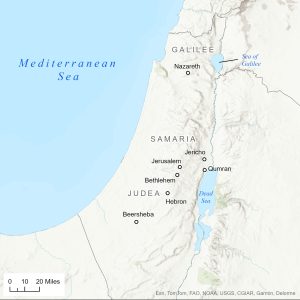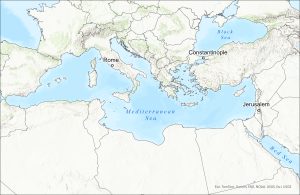53 Geography
Christianity began in the first century CE in the Roman provinces of Judea and Galilee (modern day Palestine). This area was part of what was historically known as Canaan, the home of the Israelites. It was here that the Israelites established a temple at Jerusalem as the center of their religious practice. Eventually the Israelites would adopt the name Jew -meaning those from the region of Judah. Groups living in this region survived primarily as farmers and herders of animals. The land was not easy to farm, which meant that large cities could not be sustained. Instead, small villages organized around the city of Jerusalem.
Although the land was harsh, Judea and Galilee were important crossroads of trade for many centuries. Political leadership in the region was unstable: at times the Israelites ruled the region, while at other times they were overthrown by foreign powers. Each time they were occupied, they absorbed aspects of the dominant culture. Beginning in 63 BCE, the Jews of Judea and Galilee were ruled by the Romans.
The Romans allowed the Jews to practice their religion and keep their temple as long as they did not interfere politically with Roman rule. Some Jewish groups accepted this, but others felt that the Roman occupation was oppressive. Roman rulership challenged traditional patterns of religious practice and self-rule, particularly in the religion of the villages scattered throughout Judea. These social and political forces led to a crisis within the Jewish communities of first century Judea. Some groups longed for a powerful king that would come and restore the Jews to power in Judea. They began to use the term “messiah” to refer to the anticipated leader.


